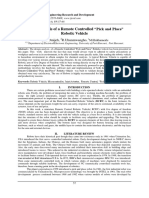0% found this document useful (0 votes)
20 views6 pages11 File Handling
The document discusses file handling in computer programs. It provides examples of how to create a new file, open a file and assign it to a file handler, read lines from a file using the file handler, write lines to a file using the file handler, check if the end of a file has been reached, and close a file once processing is complete. The examples demonstrate constructing file handling logic to read and write data from text files for input/output in algorithms.
Uploaded by
forgottenmisoCopyright
© © All Rights Reserved
We take content rights seriously. If you suspect this is your content, claim it here.
Available Formats
Download as DOCX, PDF, TXT or read online on Scribd
0% found this document useful (0 votes)
20 views6 pages11 File Handling
The document discusses file handling in computer programs. It provides examples of how to create a new file, open a file and assign it to a file handler, read lines from a file using the file handler, write lines to a file using the file handler, check if the end of a file has been reached, and close a file once processing is complete. The examples demonstrate constructing file handling logic to read and write data from text files for input/output in algorithms.
Uploaded by
forgottenmisoCopyright
© © All Rights Reserved
We take content rights seriously. If you suspect this is your content, claim it here.
Available Formats
Download as DOCX, PDF, TXT or read online on Scribd
/ 6
























































































